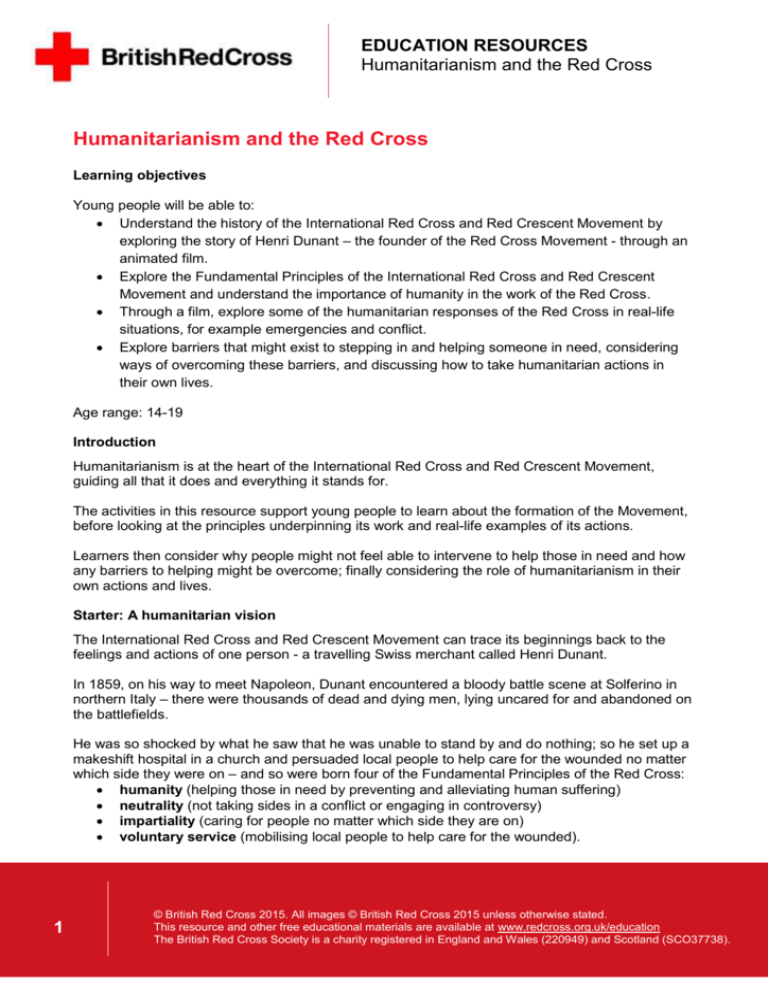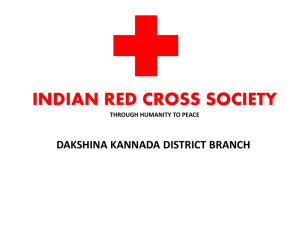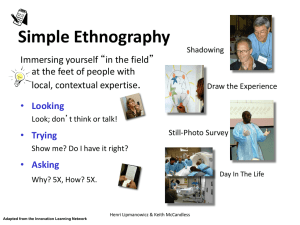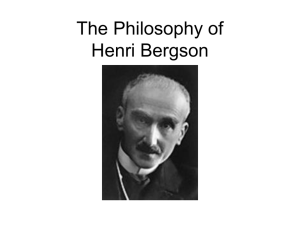Session Plan - British Red Cross
advertisement

EDUCATION RESOURCES Humanitarianism and the Red Cross Humanitarianism and the Red Cross Learning objectives Young people will be able to: Understand the history of the International Red Cross and Red Crescent Movement by exploring the story of Henri Dunant – the founder of the Red Cross Movement - through an animated film. Explore the Fundamental Principles of the International Red Cross and Red Crescent Movement and understand the importance of humanity in the work of the Red Cross. Through a film, explore some of the humanitarian responses of the Red Cross in real-life situations, for example emergencies and conflict. Explore barriers that might exist to stepping in and helping someone in need, considering ways of overcoming these barriers, and discussing how to take humanitarian actions in their own lives. Age range: 14-19 Introduction Humanitarianism is at the heart of the International Red Cross and Red Crescent Movement, guiding all that it does and everything it stands for. The activities in this resource support young people to learn about the formation of the Movement, before looking at the principles underpinning its work and real-life examples of its actions. Learners then consider why people might not feel able to intervene to help those in need and how any barriers to helping might be overcome; finally considering the role of humanitarianism in their own actions and lives. Starter: A humanitarian vision The International Red Cross and Red Crescent Movement can trace its beginnings back to the feelings and actions of one person - a travelling Swiss merchant called Henri Dunant. In 1859, on his way to meet Napoleon, Dunant encountered a bloody battle scene at Solferino in northern Italy – there were thousands of dead and dying men, lying uncared for and abandoned on the battlefields. He was so shocked by what he saw that he was unable to stand by and do nothing; so he set up a makeshift hospital in a church and persuaded local people to help care for the wounded no matter which side they were on – and so were born four of the Fundamental Principles of the Red Cross: humanity (helping those in need by preventing and alleviating human suffering) neutrality (not taking sides in a conflict or engaging in controversy) impartiality (caring for people no matter which side they are on) voluntary service (mobilising local people to help care for the wounded). 1 © British Red Cross 2015. All images © British Red Cross 2015 unless otherwise stated. This resource and other free educational materials are available at www.redcross.org.uk/education The British Red Cross Society is a charity registered in England and Wales (220949) and Scotland (SCO37738). EDUCATION RESOURCES Humanitarianism and the Red Cross The principles of impartiality and neutrality are linked. By not taking sides in a conflict and helping those in need - no matter who they are or where they are from - the Movement gains the confidence of countries and states so they can access those in need to prevent and alleviate human suffering. [You could explore young people’s understanding of the meaning of these principles by referring to the Fundamental Principles cards.] Dunant’s responses (feelings and actions) to what he witnessed at Solferino were documented and shared through his writings and through conversations he had with others on his return home to Geneva, Switzerland. He persuaded others that such terrible events should never be allowed to happen again, even in the middle of a war. In 1863, Dunant and four other men from Geneva set up the International Committee for Relief to the Wounded, later renamed as the International Committee of the Red Cross (ICRC) - its emblem being a red cross on a white background: the inverse of the Swiss flag. The ICRC has a mandate, arising from the Geneva Conventions to provide humanitarian protection and assistance for victims of armed conflict, which is as relevant today as it was in 1863.1 1. Show the short animated film The story of an idea (stopping at 3:31 minutes which is the end of the animated section) depicting Henri Dunant encountering the Battle of Solferino. Allow an initial viewing of the film – this will familiarise learners with the story. Before showing the film again, share the following prompt questions asking learners to think about them as they watch the film again. You can pause the film at different moments to ask questions if you prefer. a. What feelings do you think Henri Dunant had when he arrived in Solferino? b. How did he provide help to those he found at Solferino? c. Who did he ask or find to help him? d. Why do you think he chose to write about his experiences at Solferino? e. What skills or values do you think Henri needed to take action and do something about what he saw? f. Do you think one person can make a difference? What difference did Dunant make to those people? What difference do you think the Red Cross and Red Crescent Movement makes today? [You could discuss how the Movement provides assistance to those in crisis both in the UK and overseas.] Raising awareness: Refusing to ignore those in need 2. Ask young people to imagine that they are Henri Dunant having recently returned from Solferino to Geneva. Ask them to think about what they witnessed, how it might have made them feel, and what they would have done about it. Using these insights ask them to prepare a 1 The Geneva Conventions are four international treaties that form the basis of modern humanitarian law governing the treatment of soldiers and civilians during armed conflict. More information can be found here. 2 © British Red Cross 2015. All images © British Red Cross 2015 unless otherwise stated. This resource and other free educational materials are available at www.redcross.org.uk/education The British Red Cross Society is a charity registered in England and Wales (220949) and Scotland (SCO37738). EDUCATION RESOURCES Humanitarianism and the Red Cross speech or to write a persuasive letter, slogan or reflective poem, to persuade others to join them and prevent the events at Solferino ever being repeated. They may need to consider the following questions: a. What facts can support your argument? b. How can you appeal to people’s feelings (their humanity)? c. What persuasive language might you need to convince others of your idea? d. How will you counter criticisms or questions about what you are proposing? Young people could then deliver their work to the group, or share it with a partner. You could also suggest the group or partner ask questions to challenge their thinking, for example what practical steps might they need to take? What might be the benefits of this approach? What barriers might they face? Raising awareness: The Fundamental Principles A year after Henri Dunant and his colleagues formed the International Committee for Relief to the Wounded; an important meeting was held in Geneva and attended by 12 governments. An agreement was signed at this meeting called the Convention for the Amelioration of the Wounded in Times of War. This became the first Geneva Convention, adopted in 1864. It was later followed by a further three conventions in 1906, 1929 and 1949 and some additional protocols/practices in 1977 and 2005 to offer more protections to those affected by conflict. These make up the Geneva Conventions and their Additional Protocols and are the basis of the work of the ICRC, and gave rise to the development of Red Cross National Societies. You can learn more about the Geneva Conventions here. You can find a session plan exploring the rules of war through an animation created by the ICRC here. Around the world there are 189 National Red Cross and Red Crescent Societies who are members of the Movement. Each of these societies performs humanitarian work in its own nation as well as collaborating with other societies, the International Federation of the Red Cross (IFRC) and the ICRC when needed. All National Societies, ICRC and IFRC staff and volunteers sign up to the Fundamental Principles of the Red Cross and Red Crescent Movement. These principles are: > Humanity > Impartiality > Neutrality > Independence > Voluntary service > Unity > Universality 3. To support deeper engagement with the principles, divide learners into small groups (four to six), cut up and give one Fundamental Principle card per group. Ask them to think about how 3 © British Red Cross 2015. All images © British Red Cross 2015 unless otherwise stated. This resource and other free educational materials are available at www.redcross.org.uk/education The British Red Cross Society is a charity registered in England and Wales (220949) and Scotland (SCO37738). EDUCATION RESOURCES Humanitarianism and the Red Cross their principle supports the work of the Movement. What is important about it and how does it enable the work of the Movement to help those in need? Learners can then explain these ideas to the wider group. [You may need to clarify any unfamiliar language to help them fully understand each of the principles.] Looking at the cards, ask learners to consider why the Movement has adopted these principles. This may be easier if they are asked to consider what would happen if the principle was not there, you could also use the following prompt questions: How might it alter the ability of the Movement to perform its role? How do the principles unite those who work and volunteer for the Red Cross? What might the principles mean to those in need or crisis? Alternative method for this activity Run this activity as a walking debate. Place the cards in different parts of the room. Ask learners to stand next to the card they feel is the most important in enabling the work of the Movement. Ask learners standing next to different cards why they have chosen to stand where they have. Can they convince others to move to where they are? Give each principle the chance to be heard and then provide an opportunity for learners to move if they have changed their mind. The activity would close in the same way. Then and now: the legacy of Henri Dunant 4. Show the remainder of the film from 3:32 minutes - beyond the animated section. This part of the film shares, through the use of real images, the impact and legacy of Henri Dunant’s initial actions at Solferino. Ask learners to discuss the commonalities and developments from the initial reactions and actions taken by Dunant at the founding of the Movement to the work of the Movement today. They could discuss what help provided by the Movement in the film relates to the organisation’s Fundamental Principles. Taking action: Humanitarian action in everyday life 5. ‘Preventing and alleviating human suffering’ is central to the ethos of the Red Cross and Red Crescent Movement and can be traced right back to when Henri Dunant refused to ignore the plight of wounded soldiers at the battle of Solferino. Despite this intention, it can sometimes be difficult to help those in need – there may be barriers to action. a) There might be many barriers to helping or stepping in – can young people think of any reasons why Henri Dunant may have decided not to act? Examples that could be used as prompts include: 4 he was on his way somewhere he might not have known what to do he might have been afraid he might not have spoken their language he thought it was someone else’s responsibility. © British Red Cross 2015. All images © British Red Cross 2015 unless otherwise stated. This resource and other free educational materials are available at www.redcross.org.uk/education The British Red Cross Society is a charity registered in England and Wales (220949) and Scotland (SCO37738). EDUCATION RESOURCES Humanitarianism and the Red Cross Sometimes it takes courage to intervene to help someone. Henri Dunant provides a very good example of someone refusing to ignore those in crisis. Although Dunant was helping people in the extremes of war, it is possible to identify people in need of help or support in everyday life. b) Ask learners to talk in small groups (four to six) and identify examples of where people around them may be in need of help or support. These examples may be very local (in their home, school, youth club, etc.) or a little wider in their own community or wider society. The following prompts may be helpful to aid thinking if needed: Do you know of people who may be vulnerable or at risk in some way? Perhaps they come from another country and are new to the area, or have just come out of hospital and don’t have any friends or family nearby. Can young people think of other examples? Consider that help and support can be very practical, but may also be emotional – what skills or qualities - for example compassion, courage, inclusivity, understanding, practical help might young people need to step in and help? Remember that a crisis could be a large event like a natural disaster or conflict, but also that every crisis is personal and may be very local and specific, affecting just one individual such as a broken leg, isolation or someone’s home being flooded. Once they have some examples, ask the groups to move the discussion on by thinking about why those people might not get the help they need. What might the barriers to action be? How might these barriers be overcome to fulfil the Movements’ ethos of ‘preventing and alleviating human suffering’ and offering humanitarian support? After around 10-15 minutes of discussion, invite groups to share their examples with the wider group. Support them to draw out and understand the important idea of humanity behind everyday actions of the Red Cross and Red Crescent Movement; the principles of the Movement can be adopted by anyone. Most actions start with an individual or a small group of people - as we saw in the film with Henri Dunant – one person can make all the difference. You might like to ask learners to think about the ethos and principles of the Red Cross and Red Crescent Movement as a final reflection and to consider one humanitarian action or principle they could use in their actions and lives. Alternative method for this activity You could run this activity with young people drawing a wall of ‘bricks’ on a large piece of paper - once learners have discussed the barriers to helping they could write some of them on the bricks (one barrier per brick). Once they have done this they can either keep their own piece of paper or pass it onto another group. Writing on sticky notes groups then cover each brick or barrier with a solution for how it might be overcome. Each group should end up with a wall of bricks covered in sticky note solutions with ways to help those in need or in crisis. Groups can share their ‘wall’ with the wider group. The activity would close in the same way. 5 © British Red Cross 2015. All images © British Red Cross 2015 unless otherwise stated. This resource and other free educational materials are available at www.redcross.org.uk/education The British Red Cross Society is a charity registered in England and Wales (220949) and Scotland (SCO37738).







